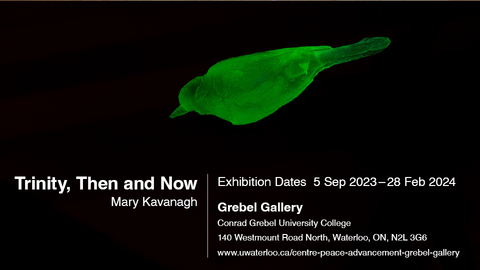
Trinity, Then and Now
by Mary Kavanagh
Nearly eighty years after the detonation of the world’s first atomic bomb, the global threat dealt by nuclear weapons lurches perilously forward. Trinity, Then and Now brings into focus and proximity the grave impact of what is considered the first significant radiological event–the Trinity atomic bomb test on July 16, 1945 in the desert of New Mexico–with reflections on its continued ecological, physiological and psychological toll.
The Grebel Gallery is pleased to present a selection of three works from Mary Kavanagh’s solo exhibition, Daughters of Uranium following her decade-long investigation into the veiled history of nuclear armament. Derived from the chemical sciences, the term “daughters of uranium” refers to the radioactive decay chain of naturally occurring Uranium (U-235 being the crucial element for sustaining a nuclear chain reaction) while evoking generations born into an uncertain future. Rich with scientific, literary, and historical references, the exhibition is conceptualized as a series of “chapters” that encourages a certain interpretive agency, while reflecting on the continuum of 20th and 21st century war.
About the artist
Mary Kavanagh is a visual artist, scholar, and educator whose work encompasses installation, video, photography, drawing, and sculpture. With a background in art history and critical theory, her art practice has been shaped by the aesthetic and social histories of representation and abstraction, by conceptualism and autoethnography.
Kavanagh’s early work was largely concerned with embodiment and memory with projects focused on the intersection of personal and political narratives. More recent projects involve immersion in sites with complex or difficult histories, and utilize research-centric methods such as field work, community engagement, investigations of material evidence, and archival practices.
Kavanagh’s artwork is exhibited across Canada and internationally. With projects in Japan, Italy, the United States (New Mexico, Utah, Nevada, Alaska), and Canada, her work has taken her to remote locations including military bases, weapons testing and research facilities, industrial ranching operations, and sites of mining extraction and remediation. These opportunities have resulted in multi-faceted exhibitions that explore the boundaries of access to publicly held lands, institutions, and data.
Kavanagh is a Professor in the Department of Art at the University of Lethbridge, and Tier I Board of Governors Research Chair (2020-2025) awarded for her research on nuclear culture. Her work is supported by grants from the Canada Council for the Arts, the Alberta Foundation for the Arts, and the Social Sciences and Humanities Research Council of Canada. In 2007 she was Visiting Professor at Hokkai-Gakuen University in Sapporo, Japan, and in 2018 she was appointed Associate Member of the Documentary Media Research Centre (DMRC), School of Image Arts, Toronto Metropolitan University. In 2021 she was elected Fellow of the Royal Society of Canada, Academy of Arts and Humanities.